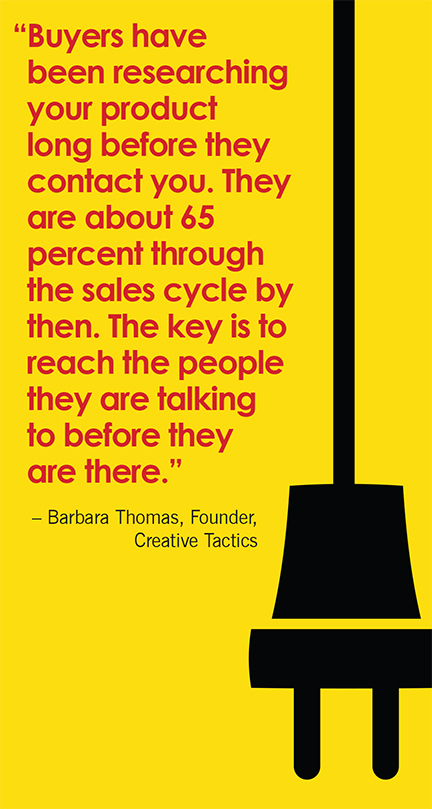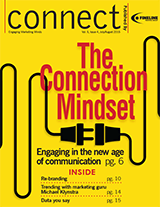Marketing in the Connection Age

Engaging in the new age of communication
Written By Charles Lunan
Like the Information Age and the Industrial Age before it, the Connection Age has not changed the fundamental purpose of marketing, which is knowing your customers.
If there is one lesson marketers have learned over the decades, it’s that all the marketing, creativity and media dollars in the world are no match for a recommendation from good ole mom and dad, a co-worker or the local yoga instructor.
While consumers have unprecedented access to product information to guide their purchasing decisions, recent research from the consulting firm Deloitte and others shows that consumers still overwhelmingly favor the opinions of their family members, friends and fellow consumers over bloggers, retail associates and other so-called experts.
 In a May 2014 survey of consumers, Deloitte found that 60 percent of respondents ranked recommendations from family and friends and customer reviews as the most trusted source of information on products and services, dwarfing the 43 percent who selected independent product/service experts or the 12 percent who chose product manufacturer/service providers.
In a May 2014 survey of consumers, Deloitte found that 60 percent of respondents ranked recommendations from family and friends and customer reviews as the most trusted source of information on products and services, dwarfing the 43 percent who selected independent product/service experts or the 12 percent who chose product manufacturer/service providers.
The good news is that the same digital infrastructure that has shifted so much power to the consumer also has enabled marketers to influence prospects during the earliest stages of their research. This is when they’re still gathering recommendations from friends and family via their social media networks and researching options on manufacturer and retailer websites.
“Buyers have been researching your product long before they contact you,” says Barbara Thomas, founder of marketing firm Creative Tactics. “They are about 65 percent through the sales cycle by then. The key is to reach the people they are talking to before they are there.”
Thomas has carved out a niche by helping business-to-business companies identify and leverage what she calls, “customer advocates.” These are the customers who willingly share their positive experiences with a product or service provider with their peers, family and friends.
“That is something you don’t see on a normal spreadsheet,” Thomas says, before citing research that shows that uncompensated customer advocates can be up to five times more valuable than other customers. That’s because they not only spend more, but because the customers they refer tend to remain customers much longer.
Connections trump knowledge
Many small businesses were reminded of this during the last recession, but the idea has gained currency since then, according to “The Shift Index,” a series of reports Deloitte began publishing in 2010 in an effort to determine why the return on assets among U.S. corporations had declined steadily since 1965.
Deloitte found that rapid technological innovation had shifted the advantage from companies that had accumulated large stores of information over a long period of time, to those that could harness the digital infrastructure to quickly form networks and tap flows of information. In other words, an organization’s ability to connect trumped its stores of intellectual property, including patents that may have taken years to develop but could become obsolete long before expiring.
The Connection Age has supplanted the Information Age
More relevant to the marketer was finding that wide availability of product information, especially prices, had eroded consumer brand loyalty. With 24/7 access to detailed product descriptions and price information, consumers were in a position to demand more.
“It’s not enough to have a great product anymore,” says Meghan Skiff, founder of Mixy Marketing, an in-bound marketing firm that has carved out a niche helping tech startups. “That’s just one box checked, but customers expect a lot more than that. They expect service, intelligence, consultative relationships, value through content and things like that. You have to be really great at serving your customer.”
Brands have turned to marketers like Skiff to help distinguish themselves in a sea of sameness and they are responding by using social media, data analytics and good old fashioned content marketing to engage customers like never before. “Now, for the first time, we can form an actual relationship with our customers based on a dialog that will actually serve them in a way that helps our business,” Skiff says.
Skiff cites the example of one brand that learned how to use social media to develop a deep understanding not only of the companies it was trying to sell to, but its employees, who would ultimately be using its products. The company used those insights to craft content and a service model that resonated deeply with its target customers and enabled it to displace more established companies as an industry thought leader.
“They know ultimately who they are serving and who they are selling to,” Skiff says. “They know what keeps their customers up at night and what their pain points are. You can call it service driven marketing. It turned a lot of heads in the industry and they are experiencing record growth.”
Featured in Connect Magazine, July/August 2015.
Read the full digital version here.

